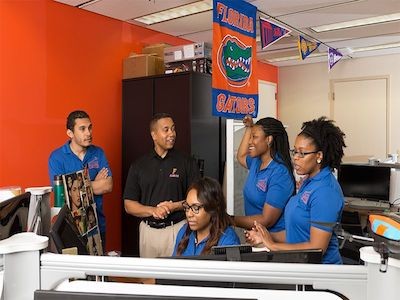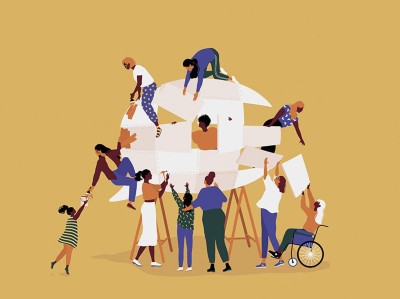
Women in senior positions walk a tightrope of acceptable behaviour as scientific leaders, argue Rachael Garrett and Alison Bentley.Credit: Klaus Vedfelt/Getty
The scientific community has made measurable, albeit slow, progress in terms of diverse representation in senior roles, particularly among women. In the United Kingdom, for example, the proportion of professors who are women has risen from 12.6% in 2000 to 28% in 2021. Yet, as two women who have held senior roles at several scientific institutions, it is our experience that women are not treated in the same way as our male counterparts. Our daily experiences can be filled with trials — including microaggressions, emotional labour, comments about our appearance and insinuations about our performance — that chip away at our mental well-being and lead us to consider leaving science as a career. We are speaking out as white women who come from privileged backgrounds, and we know that the effects of misogyny are likely to be orders of magnitude worse for female researchers of colour, who are also likely to be fewer in number, or in less-senior positions, in institutions in the global north.
Scientific collaborations are precarious territory for women
We know from the scientific literature that our experiences are not unique to us or our various workplace environments1. It is for this reason that we aim to share our common experiences of misogyny — defined here as prejudice, intentional or not, towards women — with the broader scientific community. We aim to help women to pinpoint misogynistic behaviours so that they don’t internalize them, causing further harm and eventual burnout. We highlight how female networks have enriched our personal and professional development. We provide actionable recommendations that employees can advocate for at their institutions to support the well-being and retention of all women, but especially those in senior scientific roles. Finally, we call for a rethink about leadership styles, and for recognition of the positive value that leaders from different backgrounds can bring.
Walking the tightrope
Research has confirmed the incredible double standards that women face in both public and professional settings. In a 2017 study2, researchers found that men’s use of angry tones in a mock jury experiment increased their credibility and ability to persuade others. By contrast, when women or people who identified as African American spoke forcefully, they were less likely to change people’s minds. Participants perceived the angry female and African American jurors as emotional and untrustworthy, enabling others to discredit them. As Sheryl Sandberg, former chief operating officer at Meta Platforms, and Adam Grant, an organizational psychologist, wrote in The New York Times in 2015:
“When a woman speaks in a professional setting, she walks a tightrope. Either she’s barely heard or she’s judged as too aggressive. When a man says virtually the same thing, heads nod in appreciation for his fine idea.”
Still, many women find that their challenges with misogyny have not even remotely abated as they progressed to senior positions in their fields. A lot of men are happy to support and mentor a woman who is in a junior, less-powerful position. Yet, in our experience, willingness to support and advocate generally diminishes for women as they achieve parity or seniority, and it is not replaced with a respectful working relationship of equals.

Geographer Rachael Garrett meets with collaborators Thomas Addoah, Prisca Kouakou and Joss Lyons-White at the University of Cambridge, UK.Credit: William Morgan
We have lost count of the number of times we have been encouraged to “relax” by our male colleagues when debating a point. Being called rude or irrational has become commonplace when we directly decline unfair work requests. As a recent example, when one of us (R.G.) firmly pushed back against various demands on her time before she had started a new position, one of her colleagues called her conduct unprofessional. She had not even stepped in the door, yet unfair comments had been levied against her.
Why it’s hard to prove gender discrimination in science
In scientific establishments, where collegiality is often equated with willing volunteerism and merit can be determined by intangible parameters, even the faintest perception of being difficult can produce negative career effects. For example, at a previous institution, R.G. was advised to “appear humbler and more grateful” to appease more-senior department members who would be voting on her tenure and promotion. They also suggested she organize one-to-one meetings with these men to obtain their support. On numerous occasions, A.B. has been advised to act in an appeasing way, ensuring egos were not harmed and giving deference to long-held ideas to keep male establishment figures cooperative and supportive.
It has become apparent to both of us that our career security might be threatened by perceptions of us being overconfident, difficult, assertive and unlikeable. Furthermore, we have observed that women often choose not to speak up about these issues for fear of damaging their careers. Instead of expecting us to bend over backwards to counteract negative perceptions, we ask colleagues of all genders to step up and discredit these biased reactions.

Plant geneticist Alison Bentley inspects wheat pre-breeding germplasm at the Norman E. Borlaug Experiment Station in Obregón, Mexico.Credit: Matt Hayes, Cornell University
The balancing act between protecting one’s time and appeasing others is so exhausting that we often go home at the end of the day questioning our chosen profession. Clearly, we are not alone.
A 2018 study3 by the US National Academies of Sciences, Engineering, and Medicine concluded that even when women obtain senior roles, pervasive gender-based harassment is a major contributor to them leaving their positions. The study concludes that too little attention is paid to ending the discrimination that forces women out. It is hard to measure the toll this stress takes, but it has long been established that conflict at work leads to significant physical and psychological impairment4.
Independent thinking suppressed
Whereas the double standards faced by women are increasingly recognized, what is less well understood is how these are linked to coercive behaviours that help to maintain the well-being of those who hold significant power. Women end up in a vicious cycle of being asked to do more work and, if they refuse, being personally attacked. If women can stay balanced on the impossibly narrow tightrope, they are welcome and accepted. But any deviation from expected gender norms, including challenging existing ideas, results in backlash.
How some men are challenging gender inequity in the lab
These rebukes on our behaviour, ways of working and personal characters can seem like implicit attempts to have us conform to the will of the culprit and the overall establishment. For example, one of us has regularly been told by male colleagues that she doesn’t have sufficient knowledge to make important decisions central to her job. This happens particularly when decisions challenge convention. Colleagues pass judgements as long-time beneficiaries of an institutional culture that they seem loath to reshape.
In a 2022 paper about sexism in UK business schools, organizational researcher Michaela Edwards and her colleagues termed this behaviour ‘micro-coercion’5. A concept similar to microaggressions, the word conveys how subtle, everyday harassment slowly leads to a pattern of control over women’s behaviours, workloads and accomplishments in academia.
As an example, on arrival at a new position, one of us was offered the friendly but unsolicited advice that she no longer needed to have “sharp elbows” in her new senior role. Likewise, one of us was disheartened when mentors frequently cautioned her to change her “tone”. We have both been advised by senior colleagues to keep established male colleagues happy and “onside” to gain their cooperation.
How female scientists can confront gender bias in the workplace
Policing the tone of women in leadership is unacceptable. It needs to stop. In the twenty-first century, we should no longer tolerate the idea that behaviours considered normal for men are problematic in women. Whether it is unconscious or deliberate, advice about how we should behave is rooted in the estimation that we don’t, as female leaders, have the capacity to determine how to act for ourselves. We call for people of all genders to stand up against this implicit bias and openly challenge it when it occurs.
It is key to call out this broader phenomenon as a form of gaslighting — efforts to push a person off balance psychologically to gain power and control over them. We should also condemn institutional forms of gaslighting, such as when women are told to seek leadership training or counselling in response to direct conflicts with misogynistic colleagues. Instead, we urge people to become our allies by helping to denounce misogyny when they see it. Simply asking, “Would you have said that to a man in the same position?” or “Have you asked male colleagues to do the same task?” can help individuals to improve understanding of their own biases. It is just as important to denounce misogyny when it comes from unexpected sources — such as senior women who have survived the system, have internalized it and continue to replicate it.
A band of sisters and allies
When the waves of misogyny feel soul crushing, we turn to the deep connections with like-minded female academics and scientists that have been our lifeboat. Informal women’s lunches, happy hours, WhatsApp messaging groups and more-formal gatherings for women and members of other under-represented groups have helped to put things in perspective, combat gaslighting and build resilience — and science backs up our personal experiences5. Alliances between senior and early-career women can be particularly helpful. We also encourage more intersectional connections between scientists from various career stages, marginalized backgrounds and identities.
Women in science
By collectively confronting negative patterns and behaviours, we can all help to weaken the hold of misogyny in institutions. But how exactly can we go further towards ending misogyny in science in general — or at least lessen its negative impacts? It is clear that urgent, joint action is needed to pierce systems built to reinforce the ‘correct’ leadership behaviours projected onto women. We must prevent this messaging from being internalized by more women. But how do we get there?
Ending misogyny in science
Given the subtle nature of the everyday experiences we describe, changing the culture of science is principal among the changes that institutions need to make, but also the most amorphous and ambitious goal. As a start, there needs to be greater attention paid to cultivating, harnessing and promoting all types of female leadership approach, from direct and assertive to subtle and cautious. There is not one version of leadership, despite what the long historical trail of male leaders might suggest. Women should be able to step off the tightrope to embrace a diversity of authentic leadership styles — and not just land on their feet, but also receive resounding applause. To achieve this, we need to call out comments that criticize women for not conforming to a single standard. For example, if someone describes a female job candidate as “not the right fit”, you could challenge that by asking, “Are we looking for fit to our current or future vision for the organization?”
Use microaffirmations and call out microaggressions to help others
This cultural revolution will need to be supported by all. It should involve fresh approaches, such as discussion groups, forums and book clubs, that give us a platform to share our lived experiences openly, collectively confront misogyny, envision change and support each other for who we already are. For example, departments or centres could organize an event around Arwa Mahdawi’s 2021 book Strong Female Lead: Lessons from Women in Power to help scientists to challenge their assumptions about model leaders. Mahdawi encourages us to move away from recognizing only the loudest and traditionally most powerful voices.
Although cultural change is slow, one immediate action would be to diffuse the hierarchical decision-making structures that currently empower the establishment. This means moving away from a single, all-powerful head of department or institution to a broader management committee that is more diverse in both background and leadership style. Everyone could be given an opportunity to lead on a rotation.
If this is not possible, then decision-making processes used by current leaders need to be transparent and open to robust input. All scientific establishments could also immediately standardize workloads — such as teaching, advising and service, and achievement evaluations across faculties, units or departments — to lessen the impact of implicit biases on career progression. Such a process will protect individuals’ objective work and achievements from biased perceptions (“she only got this award because she is a woman”). Likewise, anonymous faculty members voting on tenure and promotions should be required to supply specific and concrete reasons for negative evaluations.
People of all genders and all career stages should be working together to fight the misogyny status quo. Surviving as a woman in science shouldn’t be such a perilous and exhausting high-wire balancing act. We will all be more powerful and effective when female leaders are supported to be equitable participants in the diverse and holistic scientific organizations of the future.













More News
Author Correction: Stepwise activation of a metabotropic glutamate receptor – Nature
Changing rainforest to plantations shifts tropical food webs
Streamlined skull helps foxes take a nosedive